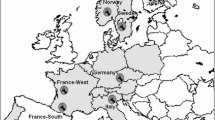Abstract
The significance of adult buck aggression as a proximate factor driving yearling male dispersal in roe deer, Capreolus Capreolus, was studied in Sweden during the dispersal season (April–June) in 1988–1991. In roe there is a well established positive correlation between yearling antler size and dispersal tendency. I tested the prediction that yearlings with large antlers will experience more agonism from adult bucks than those with smaller antlers. Additionally, I studied the relationship between antler size and level of sexual maturity, by recording date of velvet shedding, and sampling testes weights from culled yearlings during the breeding season. The amount of agonism experienced by yearlings was positively correlated with the size of their antlers during April and May, whereas in June no such relationship was found. Aggression towards all yearlings tended to increase as the season progressed. A positive correlation between antler size and testes weight was evident, and the larger the antlers of yearlings the earlier the velvet shedding occured. These results indicate: firstly, that adult buck agonism is an important proximate factor underlying yearling male dispersal; and secondly, that agonism is mainly directed towards the sexually most mature yearlings. This, in turn, suggests mate competition to be the ultimate cause of male-male agonism, and thus male dispersal in this species.
Similar content being viewed by others
References
Bideau E, Vincent JP, Quere JP, Angibault JM (1983) Occupation de léspace chez le chevreuil (Capreolus capreolus L., 1789). Acta Oecol Oecol Appl 4:163–184
Bobek B (1977) Summer food as the factor limiting roe deer population size. Nature 268:47–49
Bramley PS (1970) Territoriality and reproductive behaviour of roe deer. J Reprod Fert 11:43–70
Chaplin RE, White RWG (1972) The influence of age and season on the activity of the testes and epididymides of the fallow deer, Dama dama. J Reprod Fert 30:361–369
Clutton-Brock TH (1989) Female transfer and inbreeding avoidance in social mammals. Nature 337:70–72
Dobson FS (1982) Competition for mates and predominant juvenile male dispersal in mammals. Anim Behav 30:1183–1192
Dobson FS, Jones WT (1985) Multiple causes of dispersal. Am Nat 126:855–858
Ellenberg H (1978) Zur Populationsökologie des Rehes (Capreolus capreolus L., Cervidae) im Mitteleuropa. Spixiana Suppl 2:1–211
Goss RJ (1983) Deer antlers: regeneration, function, and evolution. Academic Press, London
Greenwood PJ (1980) Mating systems, philopatry and dispersal in birds and mammals. Anim Behav 28:1140–1162
Greenwood PJ, Harvey PH (1982) The natal and breeding dispersal of birds. Annu Rev Ecol Syst 13:1–21
Hennig R (1962) Über das Revierverhalten der Rehböcke. Z Jagdwiss 8:61–81
Kurt F (1968) Das Sozialverhalten des Rehes (Capreolus Capreolus L.). Paul Parey, Hamburg
Liberg O, Johansson A, Lockowandt S, Wahlström K (1992) Density effects in roe deer demography. Trans Congr Union Game Biol 20:125–130
Møller AP (1989) Ejaculate quality, testes size and sperm production in mammals. Funct Ecol 3:91–96
Pusey AE (1987) Sex-biased dispersal and inbreeding avoidance in birds and mammals. Trends Ecol Evol 2:295–299
Short RV, Mann T (1972) The sexual cycle of a seasonally breeding mammal, the roebuck (Capreolus Capreolus). J Reprod Fert 12:337–351
Stenseth NC, Lidicker WZ (1992) Animal dispersal, small mammals as a model. Chapman and Hall, London
Strandgaard H (1972) The roe deer (Capreolus Capreolus) population at Kalø and the factors regulating its size. Dan Rev Game Biol 7:1–205
Wahlstrom LK, Liberg O (in press) Patterns of dispersal and seasonal migration in roe deer (Capreolus capreolus). J Zool London
Wolff JO (1993) What is the role of adults in mammalian dispersal? Oikos 68:173–176
Author information
Authors and Affiliations
Rights and permissions
About this article
Cite this article
Wahlström, L.K. The significance of male-male aggression for yearling dispersal in roe deer (Capreolus capreolus). Behav Ecol Sociobiol 35, 409–412 (1994). https://doi.org/10.1007/BF00165843
Received:
Accepted:
Issue Date:
DOI: https://doi.org/10.1007/BF00165843




